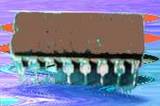Drum memory, an early form of computer memory that actualy did use a
drum as a working part with data loaded to the drum. The drum was a
metal cylinder coated with recordable ferromagnetic material. The drum
also had a row of read-write heads that wrote and then read the recorded
data.
Magnetic core memory (ferrite-core memory) is another early form of
computer memory. Magnetic ceramic rings called cores, stored information
using the polarity of a magnetic field.
Semiconductor memory is computer memory we are all familiar with, computer memory on a intergrated circuit
or chip. Referered to as random-access memory or RAM, it allowed data
to be accessed randomly, not just in the sequence it was recorded.
Dynamic random access memory (DRAM) is the most common kind of random
access memory (RAM) for personal computers. The data the DRAM chip holds
has to be periodicaly refreshed. Static random access memory or SRAM
doesn't need to be refreshed.
Timeline of Computer Memory
1834
Charles Babbage begins build his "Analytical Engine", precursor to the computer. It uses read-only memory in the form of
punch cards.
1932
Gustav Tauschek invents drum memory in Austria.
1936
Konrad Zuse
applies for a patent for his mechanical memory to be used in his
computer. This computer memory is based on sliding metal parts.
1939
Helmut Schreyer invents a prototype memory using neon lamps.
1942
The
Atanasoff-Berry Computer
has 60 50-bit words of memory in the form of capacitors mounted on two
revolving drums. For secondary memory it uses punch cards.
1947
Frederick Viehe of Los Angeles, applies for a patent for an invention
that uses magnetic core memory. Magnetic drum memory is independently
invented by several people.
- An Wang
An Wang invented the magnetic pulse controlling device, the principle upon which magnetic core memory is based.
- Kenneth Olsen
Kenneth Olsen invented vital computer components, best known for
"Magnetic Core Memory" Patent No. 3,161,861 and as being the cofounder
of Digital Equipment Corporation.
- Jay Forrester
Jay Forrester was a pioneer in early digital computer development and
invented random-access, coincident-current magnetic storage.
1949
Jay Forrester
conceives the idea of magnetic core memory as it is to become commonly
used, with a grid of wires used to address the cores. The first
practical form manifests in 1952-53 and renders obsolete previous types
of computer memory.
1950
Ferranti Ltd. completes the first commercial computer with 256 40-bit
words of main memory and 16K words of drum memory. Only eight were sold.
1951
Jay Forrester files a patent for matrix core memory.
1952
The EDVAC computer is completed with 1024 44-bit words of ultrasonic memory. A core memory module is added to the
ENIAC computer.
1955
An Wang was issued U.S. patent #2,708,722 with 34 claims for magnetic memory core.
1966
Hewlett-Packard releases their HP2116A real-time computer with 8K of
memory. The newly formed Intel starts sell a semiconductor chip with
2,000 bits of memory.
1968
USPTO grants patent 3,387,286 to IBM's
Robert Dennard
for a one-transistor DRAM cell. DRAM stands for Dynamic RAM (Random
Access Memory) or Dynamic Random Access Memory. DRAM will become the
standard memory chip for personal computers replacing magnetic core
memory.
1969
Intel begin as chip designers and produce a 1 KB RAM chip, the largest
memory chip todate. Intel soon switch to being notable designers of
computer microprocessors.
1970
Intel releases the
1103 chip, the first generally available DRAM memory chip.
1971
Intel releases the 1101 chip, a 256-bit programmable memory, and the 1701 chip, a 256-byte erasable read-only memory (EROM).
1974
Intel receives a U.S. patent for a "memory system for a multichip digital computer".
1975
Personal consumer computer
Altair
released, it uses Intel's 8-bit 8080 processor and includes 1 KB of
memory. Later in the same year, Bob Marsh manufacturers the first
Processor Technology's 4 kB memory boards for the Altair.
1984
Apple Computers
releases the Macintosh personal compututer. It is the first computer
that came with 128KB of memory. The one-megabyte memory chip is
developed.


